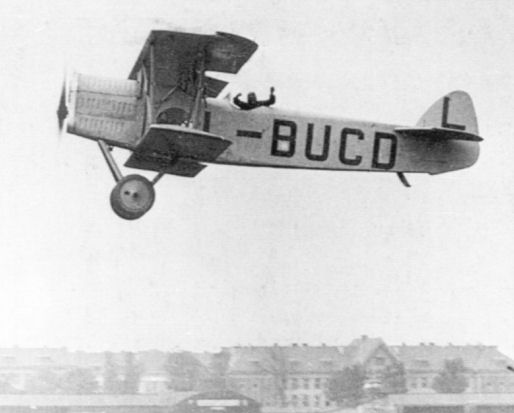
Варианты
- Aero - A.12 - 1923 - Чехословакия
- Aero - A.11 - 1925 - Чехословакия
- Aero - A.30 - 1926 - Чехословакия
- Aero - A.100 / A.101 - 1934 - Чехословакия
Aero А.11
Aero А.11 был очень удачным самолетом, созданным Антонином Гусником в период между мировыми войнами на основе похожего на него А.12 (это не ошибка, А.12 действительно появился раньше, чем А.11). Он представлял собой деревянный, обшитый тканью биплан с разными по размеру верхним и нижним крыльями. Элероны устанавливались только на верхнем крыле. Каркас фюзеляжа и расчаленного хвоста сваривался из стальных трубок, а затем обтягивался тканью. Основные колеса шасси крепились на одной оси. Удар при посадке смягчался с помощью резиновых амортизаторов.
В двух открытых кабинах размещались пилот и наблюдатель (стрелок).
Пилот сидел на уровне передней кромки верхнего крыла, в котором для лучшего обзора был сделан большой проем. Помня об уроках Первой мировой войны, на разведывательном А.11 установили направленный вперед пулемет Vickers, а в задней кабине - обращенный назад спаренный пулемет Lewis. В комплект оборудования входили фотокамера и радиоаппарат.
Главной конструктивной особенностью А.11 была возможность установки различных типов двигателя без значительных структурных переделок. Это стало одной из причин многолетнего успешного использования самолетов данного типа. Всего существовало не менее 22-х вариантов машины.
Прототип и первые самолеты А.11 оснащались двигателем Walter W-IV, выпускаемым по лицензии BMW. Это был V-образный поршневой двигатель мощностью 240 л. с. с охлаждаемым передним радиатором.
А.11 был маневренным, прочным и надежным самолетом. Благодаря этим качествам, он выпускался в больших, по тем временам, количествах. Всего было построено более 440 машин в разных вариантах.
А.11 установил ряд рекордов, включая рекорд Чехии по продолжительности полета (13 часов 15 минут), установленный 13 сентября 1925 года. Тогда же Aero А.11 занял три первых места в состязаниях на Авиационный приз президента Чехии. А в 1927 году построенный для Финляндии А.11, управляемый пилотом фирмы "Aero" Новаком, в течение 45 минут 225 раз совершил петлю.
Три варианта базового А.11 получили особые обозначения; А.21, А.25 и А.125. А.21 был ночным учебным самолетом. Он отличался от А.11 специальным оборудованием для ночного полета и двигателем Breitfeld & Danek Perun I мощностью 180 л. с. А.25 - дневной учебный самолет, двойник А.21, оснащенный однорядным поршневым двигателем BMW IIIa мощностью 185 л. с. А.125 был тем же А.11, только оснащенным двигателем Perun I.
Модификации Aero А.11
А.11H-S: разведывательный и учебный самолет, проданный в Финляндию. В целом аналогичен стандартному А.11, но имел некоторые конструктивные отличия, позволявшие установить более мощный 300-сильный двигатель Hispano-Suiza 8Fb
А.11N: ночной разведчик. Отличался от А.11 только оборудованием
Ab.11: легкий бомбардировщик на базе А.11, выпускался в двух вариантах: Ab.11d (дневной) и Ab.11n (ночной). Оба самолета имели двигатель Breitfeld & Danek Perun II мощностью 240 л. с. Отличались друг от друга только оборудованием
А.21: ночной учебный самолет, аналогичный A.11. На нем был установлен двигатель Breitfeld & Danek Perun I мощностью 180 л. с.
А.22: легкий гражданский самолет, тот же А.11 с двигателем Maybach Mb IVA мощностью 240 л. с. Задняя кабина была приспособлена для перевозки двух пассажиров
А.25: А.11 в варианте дневного учебного самолета с одним двигателем BMW IIIa мощностью 185 л. с.
А.29: Под этим названием выпускался гидросамолет А.11 с двумя поплавками. Девять таких самолетов поступили в чешские ВВС. Двигательная установка: один двигатель Breitfeld & Danek Perun II мощностью 240 л. с; длина - 9,00 м; максимальная скорость - 196 км/ч на высоте 5000 м
А.125: дневной учебный самолет. Двигатель - Breitfeld & Danek PerunI
ТАКТИКО-ТЕХНИЧЕСКИЕ ХАРАКТЕРИСТИКИ
Aero A.11
Тип: двухместный многоцелевой биплан
Силовая установка: один однорядный поршневой двигатель Walter W-IV мощностью 240 л. с.
Летные характеристики: максимальная горизонтальная скорость - 214 км/ч; крейсерская скорость - 180 км/ч; рабочий потолок - 7600 м; дальность полета - 750 км
Масса: пустого - 1030 кг; максимальная взлетная - 1537 кг
Размеры: размах крыльев: верхнего - 12,78 м; нижнего - 10,80 м; длина - 8,20 м; высота - 3,10м; площадь крыльев - 36,51 кв м
Описание:
- Aero А.11
- Flight, December 1926
The Paris Aero Show 1926
Фотографии
-
Мировая Авиация 3
Самолет А. 11, оснащенный двигателем Hispano-Suiza 8Fb, был продан ВВС Финляндии, где он под названием А.11 H-S успешно нес службу в конце 20-х годов прошлого столетия.
-
Мировая Авиация 3
Регистрационный номер: L-BUCD [2] В 1926 году A.11 совершил демонстрационный полет протяженностью 15 000 км по двадцати трем странам Европы, Северной Африки и Малой Азии.
-
Flight 1926-09 / Flight
Регистрационный номер: L-BUCD [2] A CZECHO-SLOVAKIAN AIR TOUR OF EUROPE: Capt. Stanovsky, the Czechoslovakian pilot, standing beside his "Aero" biplane (240 h.p., "Perun" engine) on his arrival at Croydon recently, during his aerial tour of Europe. His engineer is seen filling up with "Mobiloil."
-
Flight 1927-06 / Flight
THE PRAGUE AERO SHOW: The Aero A-11 two-seater reconnaissance biplane (240 h.p. Walter), constructed by Aero Tovarna Letadel, of Prague.
-
Flight 1926-12 / Flight
The Aero Ab.11 is fitted with a 240 h.p. "Perun" engine. The machine is of straightforward orthodox design and construction.
-
Flight 1927-06 / Flight
Aero A-11 240 hp Walter Engine
- Фотографии






